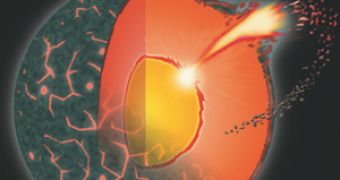Not long ago, when humans visited the Moon, there were still many theories related to the way it formed, but soon they were ruled out, one by one. For instance, one stated that it formed, like the Earth, from the accretion of space dust into increasingly larger lumps, another stated that it was born in a different region of space and captured later by our planet, a third envisioned a young Earth rotating so fast that the centrifugal force detached the Moon's matter from our planet.
But these theories were proven wrong. The first because "The density of the Moon turned out to be much lower than the Earth's density," as petrologist Wim van Westrenen, from the Free University in Amsterdam, explains, cited by Cosmos Magazine. "That excludes the accretion model, which says that the Earth and the Moon were formed from the same primordial material. [They] are simply too different." The second theory, for the opposite reason, "In that respect, the Earth and the Moon are too similar. The ratio of isotopes oxygen-17 and oxygen-18 are identical in terrestrial and lunar rock, and deviates strongly from the isotope ratio in meteorites from Mars".
As for the last, not even the calculated rotation velocity that caused a terrestrial day to be only 2.5 hour long could cause matter to be displaced, "The centrifugal force was insufficient for a Moon to escape," shared retired Dutch nuclear geophysicist Rob de Meijer. More recently, the proposal of the Moon forming from the debris resulting in the Earth's ancient massive impact with a cosmic body was largely adopted.
But de Meijer and van Westrenen propose a new possibility, that a georeactor very close to the young core, more precisely in the D'' layer (the thin, dark orange layer that can be seen in the adjacent picture) suddenly went supercritical. A powerful chemical reaction vaporized the rock, and the generated bubble rising through the molten mantle and the crust provoked an immense eruption of some trillion tons of material that gave birth to the Moon.
"The material in the Earth's mantle heated up some 8,000ºC and was completely vaporised. This huge bubble of gas forced itself up through the still liquid mantle," explains de Meijer. "As a result, part of the Earth's mantle and crust were blown away, as well as the early atmosphere. From the debris, the Moon could have formed rather quickly." Their hypothesis will be assessed and, most likely, vividly contradicted in the months to come.

 14 DAY TRIAL //
14 DAY TRIAL //